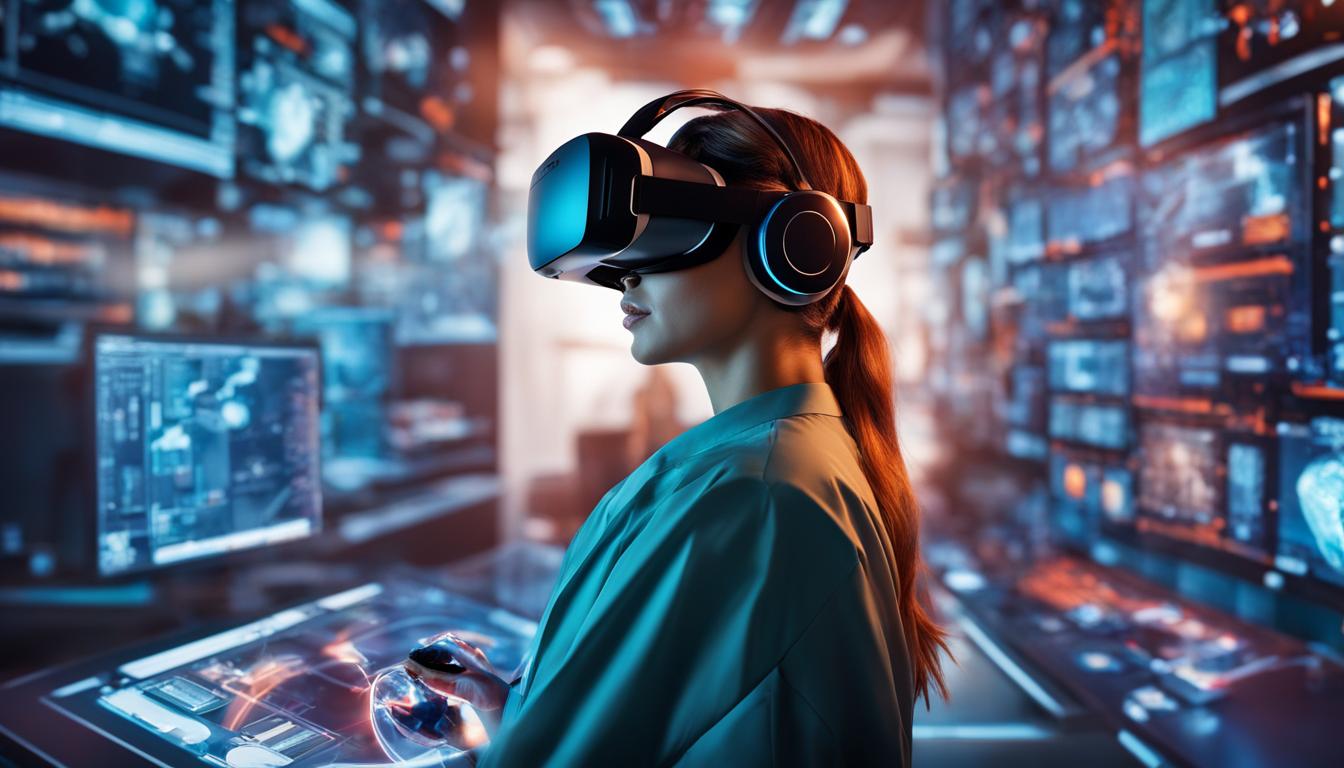Technological advances in healthcare are revolutionizing the industry. The use of 3D printing techniques, VR technology, and wireless smart bandages are just a few examples of the breakthroughs reshaping patient care and medical research. These innovations offer new possibilities for improving outcomes and transforming the healthcare experience.
Key Takeaways:
- Health technology innovations are driving significant changes in the healthcare industry.
- 3D printing, VR technology, and smart bandages are transforming patient care and medical research.
- These innovations have the potential to improve outcomes and enhance the overall healthcare experience.
- Stay updated on the latest advancements in health technology to leverage their benefits.
- Embrace cutting-edge health technology to drive positive changes in the healthcare industry.
Advancing mRNA Technology
The use of synthetic messenger RNA (mRNA) technology has emerged as a game-changer in the field of healthcare. With the success of mRNA vaccines during the COVID-19 pandemic, researchers and pharmaceutical companies are now exploring the potential of this innovative technology for developing vaccines against other diseases. Companies like Pfizer and Moderna are at the forefront of this advancement, working on mRNA-based vaccines for influenza and shingles.
Making use of mRNA technology allows for a faster and more efficient development process compared to traditional vaccine manufacturing methods. mRNA vaccines work by instructing the body’s own cells to produce a harmless piece of the target virus, triggering an immune response. This approach offers several advantages, including the ability to rapidly adapt vaccines to emerging viral strains.
The potential of mRNA technology extends beyond vaccines. Researchers are also exploring its application in therapeutics, such as using mRNA to deliver targeted therapies for various diseases. The versatility and effectiveness of mRNA technology have the potential to revolutionize the field of vaccination and therapeutics, offering new hope for improved healthcare outcomes.

Embracing Telehealth
Telehealth and virtual visits have become increasingly common in healthcare, offering patients the convenience of remote consultations. With telehealth platforms, patients can connect with healthcare providers through video calls, secure messaging, and other digital communication tools. Studies have shown high levels of patient satisfaction with virtual primary care, with many patients reporting that it helps them take charge of their health.
During the COVID-19 pandemic, telehealth saw a significant surge in usage as in-person care options became limited. However, even as the pandemic subsides, telehealth is likely to remain a fixture in healthcare delivery. The convenience and accessibility offered by telehealth make it an attractive option for patients, especially those who face mobility challenges, live in rural areas, or have busy schedules.
Telehealth platforms not only provide a convenient way for patients to access healthcare, but they also have the potential to improve overall healthcare outcomes. By enabling remote patient monitoring, telehealth allows healthcare providers to track patients’ health data, identify concerns early on, and intervene proactively. This proactive approach can lead to better disease management, reduced hospitalizations, and improved patient well-being.
Benefits of Telehealth:
- Convenience and accessibility for patients, especially those in remote areas or with mobility challenges.
- Increased patient satisfaction and engagement in healthcare.
- Proactive monitoring and early intervention for improved disease management.
- Reduced healthcare costs through fewer hospitalizations and emergency room visits.
As telehealth continues to evolve, it is crucial for healthcare providers to invest in user-friendly telehealth platforms that prioritize patient privacy and data security. Additionally, policies and regulations need to adapt to support the widespread adoption and integration of telehealth into existing healthcare systems. By embracing telehealth, healthcare providers can enhance patient care, expand access to healthcare services, and contribute to the transformation of the healthcare industry.

Adapting to Data Integration and AI

Data integration and artificial intelligence (AI) are revolutionizing the healthcare industry by improving access to complete longitudinal health records and empowering patients and healthcare providers. The seamless integration of data from multiple sources allows for a comprehensive view of a patient’s health history, enabling more accurate diagnoses and personalized treatment plans. In addition, AI and machine learning algorithms can analyze vast amounts of data quickly, aiding in rapid diagnoses, drug discoveries, and predicting patient outcomes.
“Data integration allows us to break down information silos in healthcare and unlock the full potential of patient data,” says Dr. Emily Johnson, a leading expert in health informatics. “By combining data from electronic health records, wearables, and genomic sequencing, we can gain deeper insights into disease patterns and develop targeted interventions.”
However, as these technologies advance, it is important to address the challenges they bring. Bias in AI algorithms needs to be actively monitored and corrected to ensure fair and equitable healthcare delivery. Additionally, safeguarding patient privacy and data security is paramount. Stricter regulations and protocols are being implemented to protect sensitive health information from unauthorized access and cyber threats.
The Future of Healthcare
The integration of data and AI has the potential to transform healthcare delivery and improve patient outcomes. Driven by advancements in technology and the increasing availability of data, healthcare professionals can leverage AI-powered tools to make more informed decisions, provide personalized care, and ultimately save lives.
- AI-powered virtual assistants can help healthcare providers in making accurate diagnoses and treatment recommendations.
- Predictive analytics can identify at-risk patients and intervene before their conditions worsen.
- Machine learning algorithms can analyze large datasets to identify patterns and discover new treatment options.
As the healthcare industry continues to adapt to data integration and AI, collaborations between healthcare providers, technology companies, and policymakers will play a crucial role in shaping the future of healthcare. By harnessing the power of data and AI, we can create a more efficient, patient-centric healthcare system that delivers better outcomes for all.
Data Security in Healthcare: Protecting Against Ransomware Attacks
Data security is a critical concern in the healthcare industry, especially with the increasing use of electronic medical records and the rise in ransomware attacks. Ransomware attacks target personal health information, encrypting it and holding it hostage until a ransom is paid. These attacks can disrupt healthcare services, compromise patient privacy, and result in significant financial losses for healthcare organizations.

To protect against ransomware attacks, healthcare organizations must prioritize cybersecurity measures and adhere to regulations such as the Health Insurance Portability and Accountability Act (HIPAA). HIPAA compliance ensures that patient data is securely stored, transmitted, and accessed, safeguarding sensitive information from unauthorized access and data breaches. Encryption of data at rest and in transit, along with multi-factor authentication, can provide an additional layer of security.
In addition to implementing robust security measures, healthcare organizations are leveraging artificial intelligence (AI) to detect and defend against cyber threats. AI algorithms can analyze patterns and identify anomalies in network traffic, helping to identify potential attacks before they cause significant damage. Regular employee cybersecurity training and awareness programs are also essential in mitigating the risk of human error and ensuring a culture of security within healthcare organizations.
The Importance of Data Security in Healthcare
Data security is not only essential for protecting patient privacy, but it also plays a crucial role in maintaining trust in the healthcare system. Patients need to feel confident that their personal information is safe and that healthcare providers are taking all necessary measures to protect their data. By prioritizing data security and implementing robust cybersecurity measures, healthcare organizations can ensure the confidentiality, integrity, and availability of patient information, ultimately improving patient outcomes and fostering a stronger healthcare ecosystem.
Creating New Pharmaceutical Products
The pharmaceutical industry continues to drive medical innovations with the development of new drug treatments. These advancements in pharmaceuticals have the potential to significantly improve patient outcomes and address unmet medical needs.

One notable example is the drug Inclisiran, which has shown promise in treating cardiovascular disease. Inclisiran works by targeting a specific gene involved in cholesterol regulation, helping to lower LDL cholesterol levels. Clinical trials have demonstrated its effectiveness in reducing LDL cholesterol by up to 50%, providing a new option for patients with high cholesterol who are at risk for heart disease.
Another exciting development is the drug Mavacamten, which has shown potential in treating a rare heart condition called obstructive hypertrophic cardiomyopathy (HCM). Mavacamten works by inhibiting a specific protein that plays a role in thickening of the heart muscle. Clinical trials have shown promising results in reducing symptoms and improving exercise capacity in patients with HCM.
These advancements in the pharmaceutical industry highlight the ongoing efforts to discover new treatments and improve patient care. As researchers delve deeper into the understanding of disease mechanisms and molecular pathways, new opportunities for targeted therapies and personalized medicine are emerging. The development of new pharmaceutical products holds great promise for the future of healthcare, offering hope for patients and healthcare professionals alike.
Capitalizing on Augmented and Virtual Reality
Augmented reality (AR) and virtual reality (VR) technologies have been making significant strides in the healthcare industry, opening up new possibilities for improving patient care and medical training. These immersive technologies have the potential to enhance physician training and reduce patient pain and anxiety, ultimately transforming healthcare delivery.
AR and VR are particularly valuable in physician training, providing an interactive and realistic environment for surgeons to practice complex procedures. Through virtual simulations, surgeons can refine their skills, explore different techniques, and gain valuable experience without putting patients at risk. This technology allows for a more hands-on, immersive learning experience, ensuring that healthcare professionals are better prepared for real-world scenarios.
Beyond training, AR and VR can also be used to reduce patient pain and anxiety. By creating virtual environments, healthcare providers can distract patients during painful procedures, such as injections or wound dressings. Studies have shown that these immersive experiences can significantly reduce pain perception and anxiety levels, enhancing the overall patient experience and improving outcomes.
As the global AR and VR healthcare market continues to grow, the healthcare industry should embrace these technologies to capitalize on their potential. From improving physician training to reducing patient pain and anxiety, AR and VR have the power to revolutionize healthcare delivery and enhance patient care.

Implementing 3D Printing
3D printing is revolutionizing the field of healthcare, offering innovative solutions for personalized patient care. This groundbreaking technology allows for the creation of customized medical devices, artificial organs, and models for surgical planning, paving the way for improved treatment outcomes and reduced healthcare costs.
One of the key advantages of 3D printing in healthcare is its ability to produce personalized medical devices. By scanning a patient’s anatomy and utilizing 3D printing technology, healthcare professionals can create custom-fitted prosthetics, orthotics, and dental implants. This personalized approach ensures a better fit and function, enhancing patient comfort and quality of life.
Additionally, 3D printing has opened up new possibilities in the field of organ transplantation. Researchers are exploring the use of 3D printers to fabricate artificial organs, such as kidneys and hearts, using bio-compatible materials and the patient’s own cells. This advancement has the potential to address the shortage of donor organs and provide patients with life-saving treatments.
Furthermore, 3D printing plays a crucial role in surgical planning and education. Surgeons can utilize accurate 3D-printed models of a patient’s anatomy to practice complex procedures, reducing the risk of complications during surgery. This technology also allows for better communication between healthcare providers and patients, as visually representative models can help individuals understand their treatment plans.
Advantages of 3D Printing in Healthcare:
- Customized medical devices for better patient outcomes
- Potential for developing artificial organs to address organ shortages
- Improved surgical planning and education
- Enhanced communication between healthcare providers and patients
3D printing is not just revolutionizing healthcare; it is personalized healthcare at its best. The ability to create custom medical devices and artificial organs offers endless possibilities for improving patient outcomes and transforming the healthcare experience. With continued advancements in 3D printing technology, we can expect even more innovative applications that will shape the future of healthcare.
Conclusion
The rapid advancements in health technology innovations are transforming the healthcare industry, paving the way for a new era of patient care, diagnosis, and treatment. From the revolutionary mRNA technology and the widespread adoption of telehealth to the power of AI, data integration, and 3D printing, emerging healthcare technologies offer transformative solutions for improved healthcare outcomes.
These innovations, such as mRNA vaccines for COVID-19 and the potential for developing vaccines for influenza and shingles, demonstrate the incredible potential of health technology to revolutionize vaccination and therapeutics. The convenience and accessibility of telehealth have been highly valued by patients, with virtual visits empowering individuals to take charge of their health and enabling healthcare delivery outside traditional settings.
Data integration and AI are driving major improvements in healthcare by providing better access to comprehensive health records and enabling AI-assisted diagnoses, drug discoveries, and personalized treatments. However, challenges like addressing bias in AI algorithms and ensuring patient privacy and data security continue to be important considerations.
As we look to the future, embracing these emerging healthcare technologies is crucial for creating a more accessible and efficient healthcare system. By harnessing the power of Health Technology Innovations, we have the opportunity to transform patient care, improve outcomes, and find innovative solutions to address unmet medical needs. With ongoing advancements and the limitless potential of these transformative healthcare solutions, the future of healthcare is set to reach new heights.
FAQ
What are some examples of technological advances in healthcare?
Some examples of technological advances in healthcare include 3D printing, VR technology, wireless smart bandages, and synthetic messenger RNA (mRNA) technology.
How is mRNA technology revolutionizing the field of vaccination?
mRNA technology, as seen in the COVID-19 vaccines from Pfizer and Moderna, has the potential to revolutionize vaccination by enabling the development of vaccines for other diseases, such as influenza and shingles.
What are the benefits of telehealth and virtual visits?
Telehealth and virtual visits offer patients the convenience of remote consultations, allowing them to take charge of their health. Studies have shown high levels of patient satisfaction with virtual primary care.
How are data integration and artificial intelligence improving healthcare?
Data integration allows for better access to complete health records, empowering patients and healthcare providers. Artificial intelligence and machine learning aid in rapid diagnoses, drug discoveries, and personalized treatments.
How is healthcare data being secured?
Healthcare organizations are focusing on encrypting data and leveraging AI to defend against cyber threats. HIPAA compliance remains crucial in ensuring the privacy and protection of patient data.
What are some promising advancements in pharmaceuticals?
Promising advancements in pharmaceuticals include drugs like inclisiran, mavacamten, and NK3R antagonists, which show potential in treating various conditions.
How are augmented and virtual reality being used in healthcare?
Augmented and virtual reality technologies are finding application in physician training and pain reduction. They can enhance surgical training, visualize veins, and reduce patient pain and anxiety.
How is 3D printing revolutionizing healthcare?
3D printing enables the development of customized medical devices, artificial organs, and models for surgical planning. It has the potential to improve patient outcomes, reduce healthcare costs, and drive personalized healthcare.
What is the impact of health technology innovations on healthcare?
Health technology innovations are revolutionizing patient care, diagnosis, and treatment. They offer new possibilities for improving outcomes, transforming the healthcare experience, and creating a more accessible and efficient healthcare system.


